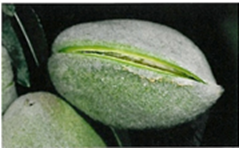Evie Smith, UCCE SRA, South Sacramento Valley.
Franz Niederholzer, UCCE Orchard Advisor, Colusa, Sutter and Yuba Cos.
Katherine Jarvis-Shean, UCCE Orchard Advisor Yolo, Solano, & Sacramento Cos.
Luke Milliron, UCCE Orchard Advisor, Butte, Glenn and Tehama Cos.
Please note that the following are general recommendations intended to help you keep track of regular practices in a busy time; the optimal timing for management practices may vary based on specific location and conditions.
- NOW Management in pollinizers: After Nonpareil harvest you may want to spray pollinizer varieties for NOW management. The decision of whether to spray or not should be based on the amount of NOW damage observed in your Nonpareil almonds, progression of the third NOW generation, and when the fourth generation egg laying will start. If you do choose to spray, plan your application timing based on when you expect to harvest your pollinizers, remembering that pre-harvest intervals are based on the date that you shake, not the date that you pick up the almonds from the orchard floor.
- Hull Boron Samples: Unlike many other nutrients, boron tends to accumulate in almond hulls, making hulls the best source of information about boron levels in your trees. If you have concerns about high or low boron levels in your orchard, collect hull samples at harvest and submit them to an analytical lab for boron analysis. See this article from the Almond Doctor for more information on hull boron sampling.
- Nitrogen application: Apply your last nitrogen of the year just before or after harvest to support next year’s bud development. Use your July leaf sample results to decide how much N you may need to apply this year. If the July leaf levels are adequate to high, no further N application may be needed. If leaf levels are low, consider irrigation water nitrate levels when deciding on N fertilizer rates. For more information about N application in almonds see the new publication “Nitrogen Best Management Practices” from the Almond Board and the CDFA’s California Crop Fertilization Guidelines for Almonds.
- Rust: Look out for rust in young orchards. Rust can cause early defoliation, which can reduce flower counts next year. For more information on rust control in almond orchards, see UC IPM.
Harvest
- Harvest when 100% of nuts are at Stage 2C of hull split or more (see image below) and test trees shake clean. This will minimize NOW egg laying and feeding damage on the harvested nuts.

Stage 2C of hull split. This is the critical time for NOW insecticide and Rhizopus hull rot fungicide applications. The orchard is ready for harvest when all nuts are at Stage 2C.
- Dust: Dust at harvest can create unhealthy conditions for workers and community members in and around almond orchards. Plan to minimize dust at harvest by adjusting sweeper head heights, blower spout angles, and fan speed. For other recommendations, see this article from the Almond Board of California.
- Shaker damage: Limit shaker damage by making sure all trees in the orchard are ready to shake when starting harvest. Test-shake trees in areas that are historically the most vigorous and where nuts “stay green” the longest. Where scaffold heights allow, clamp closer to the scaffold crotch rather than lower down on the trunk to minimize root damage and get the best shake to the canopy. In young (third and fourth leaf) orchards, be extra careful when shaking.
- Nut Damage Analysis: Nut damage analysis (harvest samples) can help you understand the primary sources of nut damage in your orchard and plan for reducing damage next year. After shaking and before sweeping, collect 500 nuts throughout your orchard for analysis. Use the UC IPM Harvest Sample resource and our article on Harvest Damage Evaluation for Almonds to conduct your damage analysis. If you don’t have time to crack out your nuts at harvest, you can freeze them at harvest and crack them out later
- Don’t stockpile wet nuts: Nuts with hull moisture above 12%, kernel moisture above 6% or total fruit (hull and kernel) moisture above 9% shouldn’t be stockpiled as nut quality could be reduced by mold and concealed damage. When sampling for moisture ahead of nut pickup in the orchard, make sure to sample from the top and bottom of the windrow, as nuts on the bottom tend to have higher moisture content than those on the top of the windrow.
Post-harvest
- Post-harvest irrigation: Return irrigation to your trees as quickly as possible after harvest to minimize water stress as much as possible. Water stress in August-October can interfere with next year’s bud development and lead to defoliation, which reduces tree vigor. Dry trees after harvest = fewer flowers next spring.
- Post-harvest hull rot and shaker damage assessments: Check for hull rot and shaker damage on your trees after harvest. More information about hull rot assessment and management can be found on the UC IPM website for hull rot management in almonds.


Leave a Reply